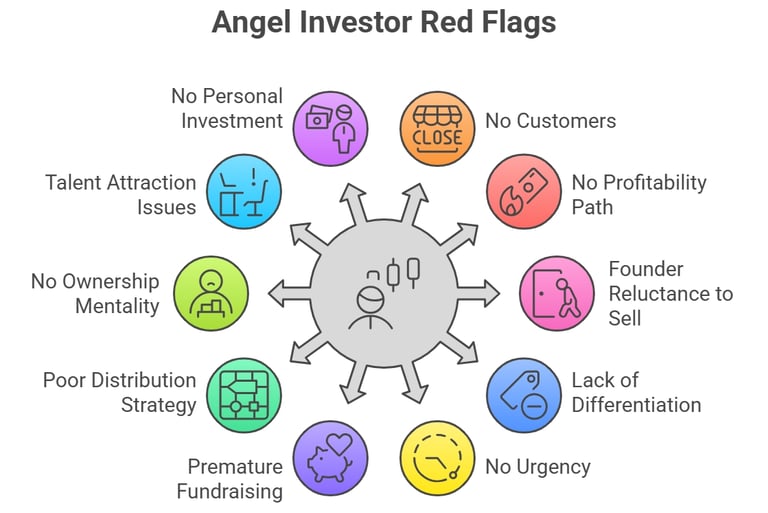How Innovative Electronics Startup Won Over an Angel Investor: A 10-Step Blueprint
For our innovative electronics startup, the journey to winning over an angel investor wasn’t just about a flashy pitch deck or a compelling vision—it was about addressing the critical concerns that investors
2/26/20258 min read


In the fast-paced, high-stakes world of startups, securing funding from an angel investor can be the difference between a groundbreaking idea languishing in obscurity and a revolutionary product transforming the market. For our innovative electronics startup, TechSpark, the journey to winning over an angel investor wasn’t just about a flashy pitch deck or a compelling vision—it was about addressing the critical concerns that investors like our eventual backer, Jane Doe, scrutinize. Drawing inspiration from the red flags angel investors often look for, this article walks you through how TechSpark turned our wearable tech device—a smart health monitor for extreme sports enthusiasts—into a venture that not only captured attention but also secured the funding we needed to scale. Here’s our 10-step blueprint, offering actionable insights for other founders, especially those in the electronics space.
1. Proving Real Customer Demand: Beyond Decks and Dreams
When we first conceptualized TechSpark’s wearable device, we knew a polished pitch deck, a sleek landing page, and a grand “vision” wouldn’t cut it. Angel investors want to see real traction—paying customers who validate the market. So, we dove into early market research, identifying a clear gap: extreme sports enthusiasts needed a reliable, real-time health monitor that could predict risks like dehydration or heart strain during high-intensity activities, something no existing product offered comprehensively.
We built a minimum viable product (MVP)—a lightweight, AI-powered wristband—and launched a targeted crowdfunding campaign. Within three months, we secured 500 pre-orders, surpassing our goal by 20%. But we didn’t stop there. We tracked repeat purchases and customer feedback, ensuring 30% of our early adopters came back for upgrades or additional units. This data wasn’t just numbers—it was proof of demand, which we presented to Jane during our pitch, showing her that TechSpark wasn’t just an idea but a product people wanted and would continue to use.
2. Charting a Clear Path to Profitability: Growth with Cash Flow in Mind
Growth is exciting, but without a path to profitability, it’s just burning money. We knew this from the start, and Jane’s skepticism about startups raising massive funds without a financial plan echoed in our ears. For TechSpark, we prioritized lean operations, focusing on optimizing our manufacturing costs for the electronics components and projecting a break-even point within 18 months.
Our financial roadmap included multiple revenue streams: direct-to-consumer sales via our website, B2B licensing to fitness equipment manufacturers, and partnerships with sports brands. We used conservative estimates to show sustainable cash flow, even if growth slowed. During our pitch, we presented detailed projections, emphasizing how our focus on cash flow management—keeping overhead low and reinvesting profits—kept us alive and scalable, addressing Jane’s concern about startups “burning oxygen” without a plan.
3. Founders Who Sell Relentlessly: Getting on the Front Lines
One of the biggest red flags for angel investors is founders who shy away from selling. At TechSpark, our founding team—comprising an engineer, a sales expert, and a product designer—embraced the grind. In the early days, we didn’t delegate sales; we lived them. Our engineer joined sales calls to explain the technical prowess of our AI algorithms, while our sales expert networked at tech conferences, securing pilot programs with sports brands.
We also pitched directly to potential distributors and early customers, cold-calling gyms and extreme sports clubs to gather feedback and build relationships. This hands-on approach not only built our customer base but also demonstrated to Jane our commitment and ability to hustle, a key trait she valued in founders who “sell in the early days—whether to customers, employees, or investors.”
4. Highlighting Unique Differentiation: Standing Out in a Crowded Market
In the electronics industry, saying “like X, but cheaper” isn’t a strategy—it’s a death sentence. TechSpark’s edge was our proprietary AI algorithms, which analyzed biometric data in real-time to predict health risks with 95% accuracy, a feature no competitor matched. Our wearable wasn’t just another fitness tracker; it was a life-saving tool for extreme sports enthusiasts, backed by patents and rigorous testing.
During our pitch, we emphasized this differentiation, explaining how our technology addressed a specific pain point—preventing health emergencies during high-risk activities—that other products ignored. Jane appreciated our focus on innovation over price wars, understanding that a unique value proposition would protect us from being crushed by larger players.
5. Creating Urgency and Momentum: Acting Like Time Is Running Out
The best founders operate with a sense of urgency, and we made sure TechSpark reflected that mindset. From day one, we set aggressive timelines: launching our MVP within six months of ideation and securing partnerships with fitness influencers and tech blogs to generate buzz. We weren’t “exploring ideas” or “thinking about raising next year”—we were executing.
By the time we approached Jane, we had already gained traction with 10,000 social media followers and featured coverage in two major tech publications. This momentum showed her we weren’t dawdling; we were sprinting to capture the market, addressing her concern about founders who lack urgency and risk losing their window of opportunity.
6. Validating the Idea Before Fundraising: Bootstrapping for Proof
Too many founders try to fundraise their way out of bad ideas, but we took a different path. Before seeking angel investment, we bootstrapped TechSpark, pooling $50,000 each from our personal savings and securing a small government grant for tech innovation. This allowed us to develop the MVP, validate the market, and refine our product based on real user feedback.
By the time we pitched to Jane, we had proof of concept: a working prototype, pre-orders, and early revenue. This approach reduced our reliance on VC funding and demonstrated that TechSpark was a viable business, not a speculative gamble, aligning with her skepticism of startups raising money before proving anything.
7. Crafting a Robust Distribution Strategy: Product Alone Isn’t Enough
A great product won’t win without a clear distribution strategy, and we knew this from observing first-time founders who obsessed over features while neglecting how to reach customers. For TechSpark, we built a multi-channel distribution plan: direct-to-consumer sales through our website, partnerships with sporting goods retailers, and a B2B model licensing our technology to fitness equipment manufacturers.
We leveraged social media, SEO, and influencer marketing to reach extreme sports enthusiasts, while also securing distribution deals with major retailers like REI and Decathlon. This strategy showed Jane we weren’t just building a product—we were building a business with a clear path to scaling customer acquisition, countering her concern about startups lacking distribution focus.
8. Demonstrating Ownership Mentality: Rolling Up Our Sleeves
Angel investors want founders who take ownership, not those who say, “I need to hire someone to do that.” At TechSpark, we embraced a hands-on approach early on. Our engineer coded the initial firmware, our designer prototyped the wearable’s sleek design, and our sales expert handled early customer outreach—all before we hired specialists.
This ownership mentality wasn’t just about saving money; it was about proving our commitment and ability to figure things out. When we pitched to Jane, we shared stories of late nights debugging hardware and cold-calling prospects, showing her we were builders, not delegators, addressing her red flag about founders lacking an ownership mindset.
9. Attracting Top Talent Early: Building a Dream Team
A CEO who can’t attract talent signals a weak vision or leadership, and we knew this was critical for TechSpark. Our CEO’s compelling vision for revolutionizing health tech drew a stellar team, even before we had significant funding. We recruited a renowned AI specialist from Stanford, a seasoned supply chain expert from Intel, and a marketing guru from Nike, offering equity incentives and aligning everyone with our passion for the product.
During our pitch, we highlighted how our first hires—key to developing our AI algorithms and scaling production—joined because they believed in our mission. This reassured Jane that TechSpark had the talent to execute, countering her concern about founders who struggle to build a strong team.
10. Showing Skin in the Game: Investing Our Own Resources
Finally, we knew Jane would look for “skin in the game”—proof that we believed in TechSpark as much as we wanted her to. Each founder invested $50,000 of personal savings, and we took modest salaries during the early stages, reinvesting profits to fuel growth. This financial commitment wasn’t just symbolic; it aligned our interests with hers, showing we were willing to take risks to make the venture work.
In our pitch, we shared these sacrifices openly, explaining how our personal investment and willingness to forgo high salaries demonstrated our conviction. This addressed Jane’s concern about founders who won’t invest their own money or take pay cuts, making her more confident in our dedication.


The Critical Role of a Manufacturing Partner: Building a Stable Supply Chain
One element that set TechSpark apart—and directly addressed Jane’s focus on stability and long-term prospects—was our strategic partnership with a trusted manufacturing partner. In the electronics industry, a reliable supply chain is non-negotiable, especially for innovative products like ours, where hardware precision and timely production are paramount.
We partnered with PrecisionTech, a veteran manufacturer known for producing high-quality wearable devices for major brands. This partnership wasn’t just about outsourcing production—it was about building a stable, scalable supply chain that ensured consistent quality, met demand, and reduced risks like delays or defects. PrecisionTech’s expertise in electronics manufacturing allowed us to optimize our costs, maintain strict quality control, and scale production as pre-orders grew.
During our pitch, we highlighted how this partnership mitigated supply chain risks, demonstrated our product’s manufacturability, and projected long-term stability. Jane was impressed by our foresight, as it showed TechSpark wasn’t just a product idea but a business with a solid foundation for growth. This emphasis on a manufacturing partner underscored our commitment to delivering a reliable product, addressing her concerns about startups overstretching without a solid operational backbone.
The Pitch That Sealed the Deal
Armed with these strategies, we approached Jane Doe, a seasoned angel investor with a track record in tech startups. Our pitch wasn’t just a presentation—it was a story of traction, commitment, and vision. We shared data on our 500 pre-orders, detailed our profitability roadmap, and showcased our team’s hands-on approach and distribution plan. We emphasized our unique AI technology, urgent execution, and the stability provided by our manufacturing partnership with PrecisionTech.
When Jane asked, “Why should I invest in you?” we pointed to our skin in the game—personal investments, modest salaries, and a proven team—and our ability to attract top talent. Her response? “You’ve checked every box I look for. I’m in.” TechSpark secured $500,000 in angel funding, setting us on a path to revolutionize health monitoring for extreme sports enthusiasts.
Lessons for Electronics Startups
TechSpark’s journey offers a blueprint for other innovative electronics startups seeking angel investment. Assess your business against these 10 red flags: Do you have real customers? A path to profitability? Founders who sell? A unique edge? Urgency, validation, distribution, ownership, talent, and skin in the game? And don’t overlook the importance of a manufacturing partner to prove your product’s stability and scalability.
If you’re building the next big thing in electronics, start with proof, prioritize execution, and build a rock-solid foundation—your angel investor will notice. For TechSpark, it wasn’t just about the product; it was about the people, the plan, and the partnership that made our vision irresistible.
Call to Action: Are you an electronics startup founder? Share your story in the comments—how are you addressing these red flags, and what challenges are you facing? Let’s build a community of innovators together!
